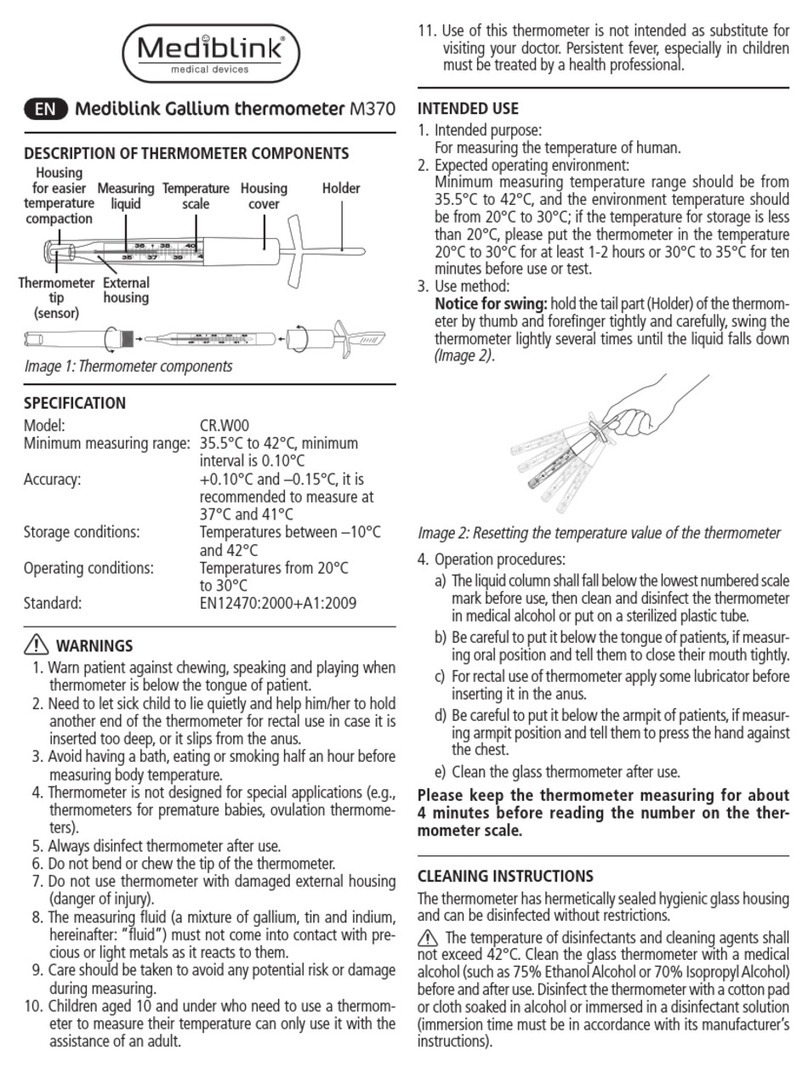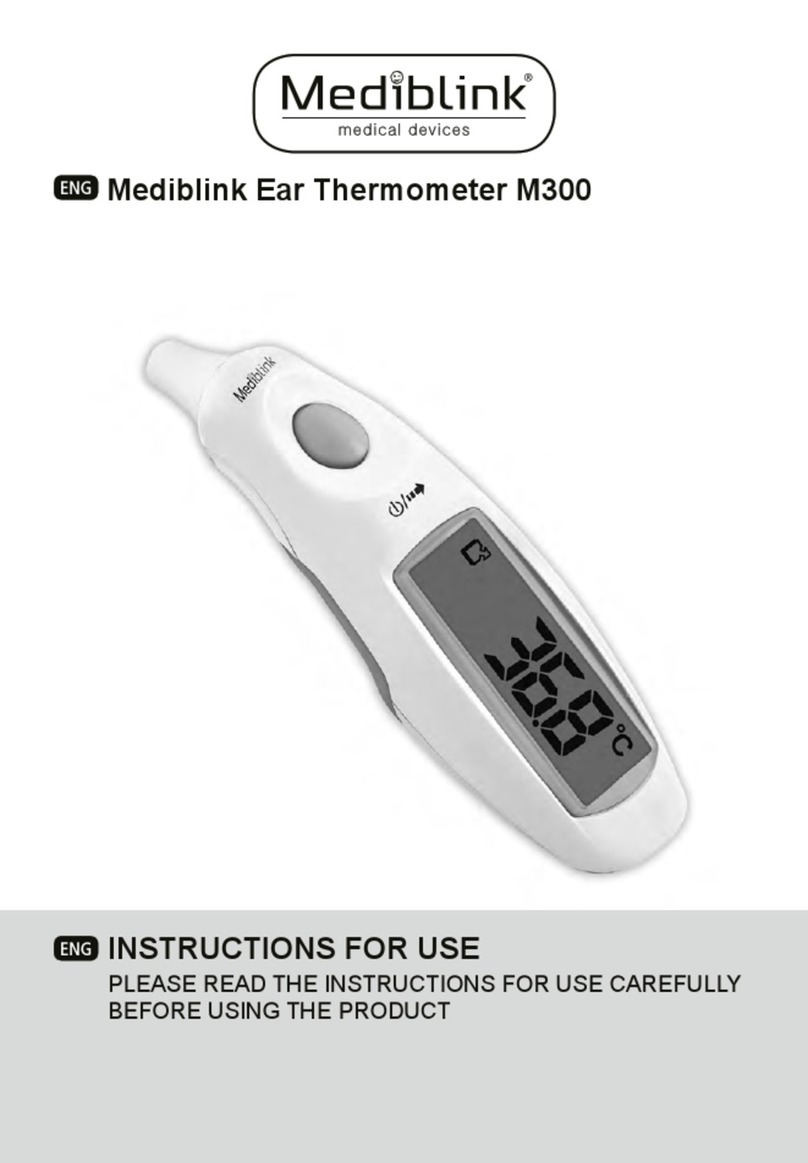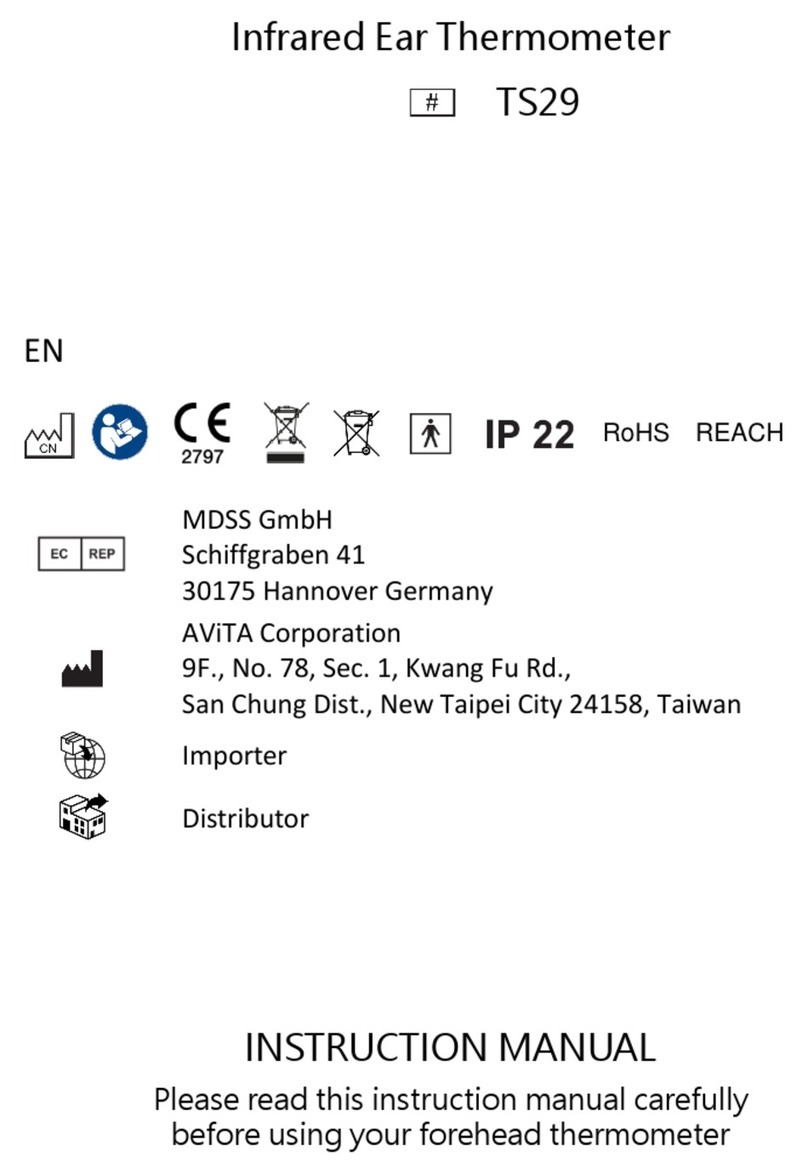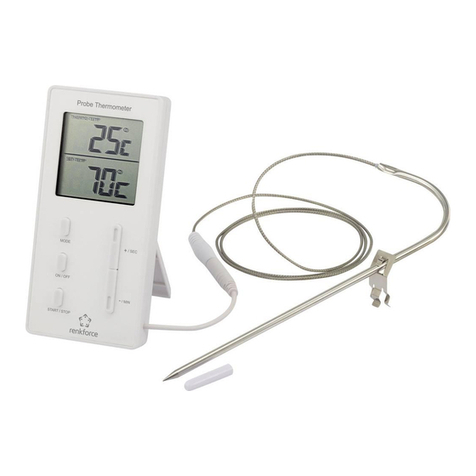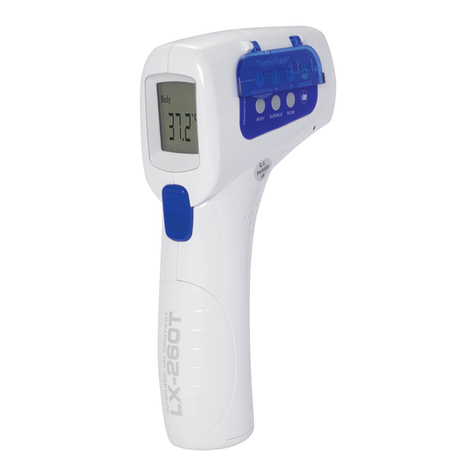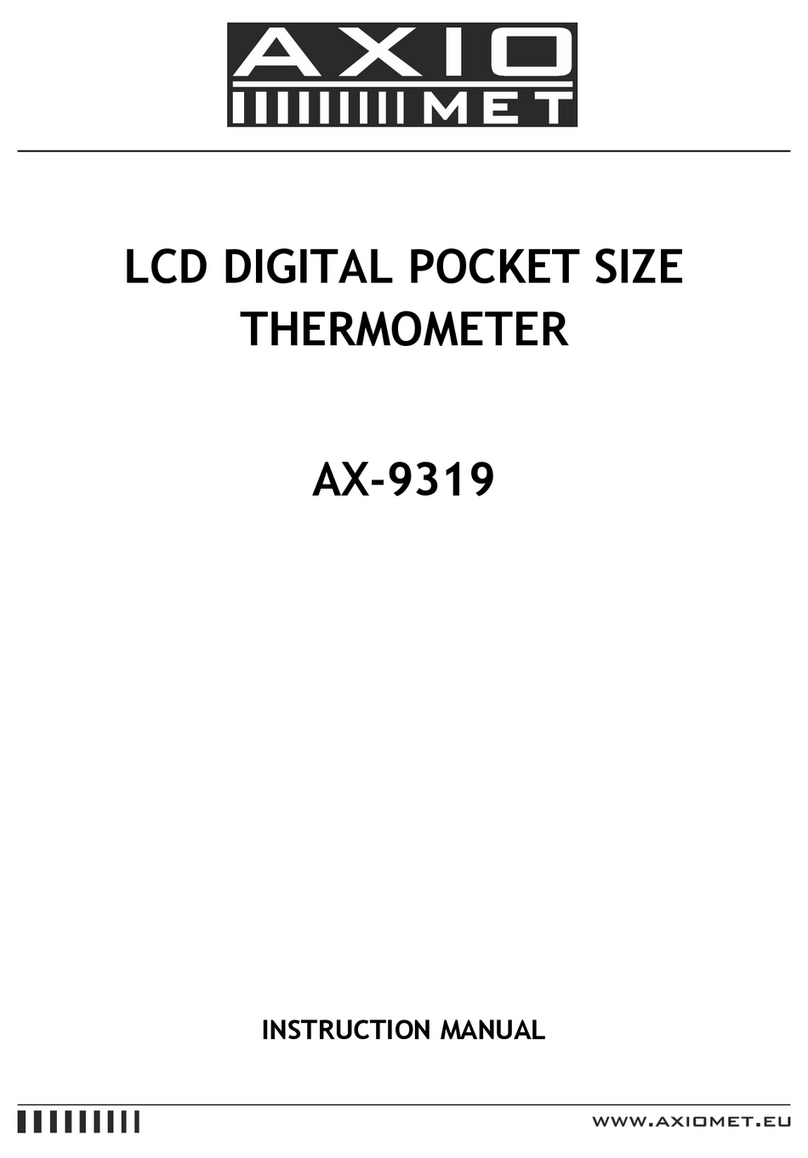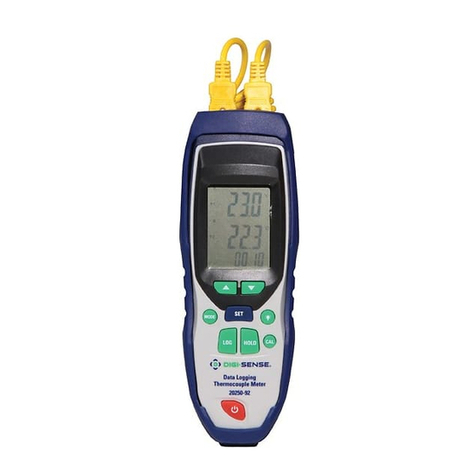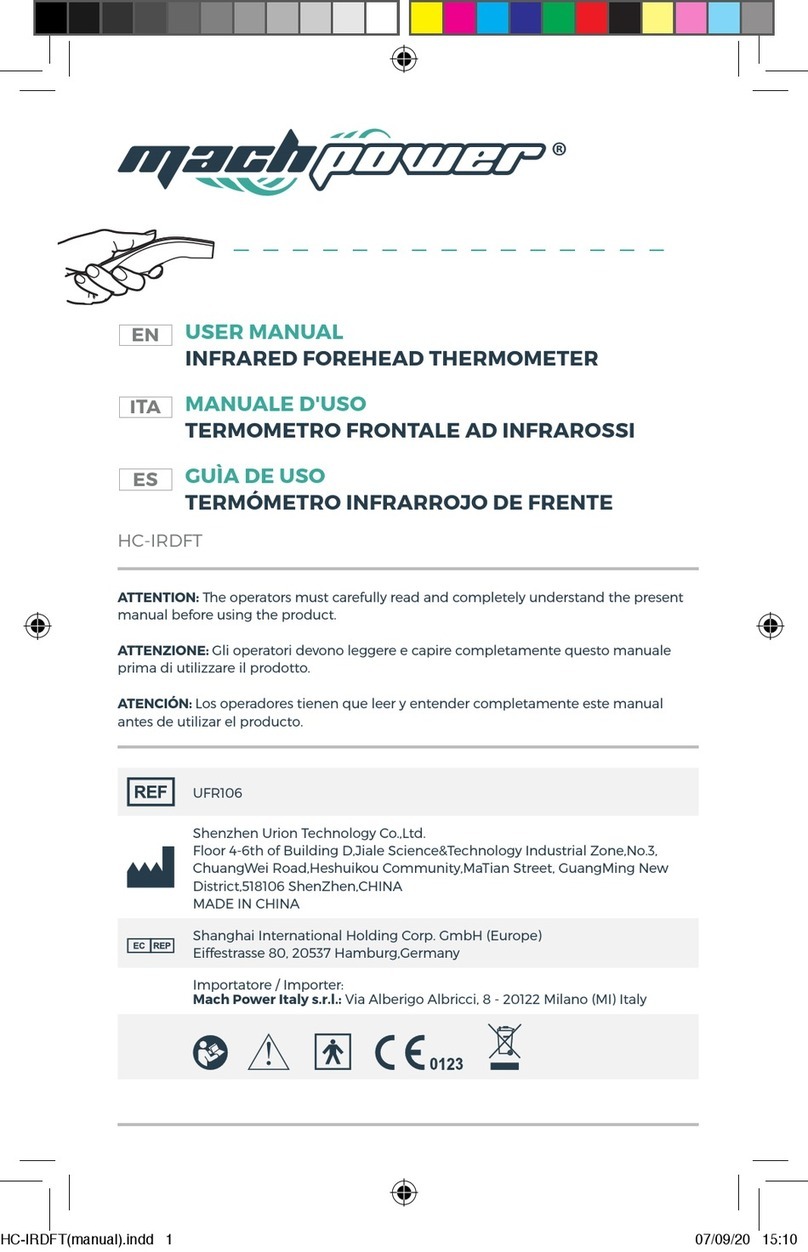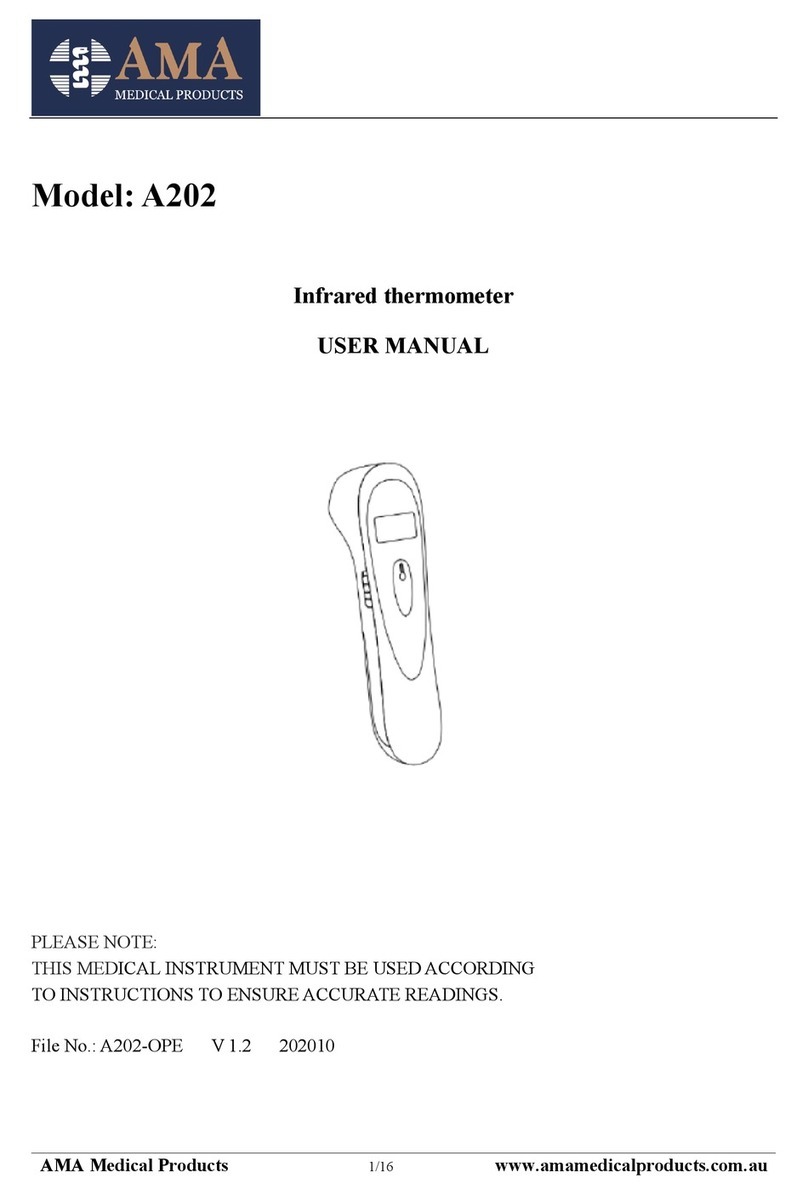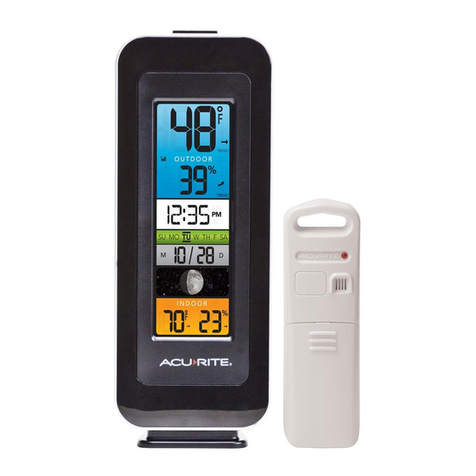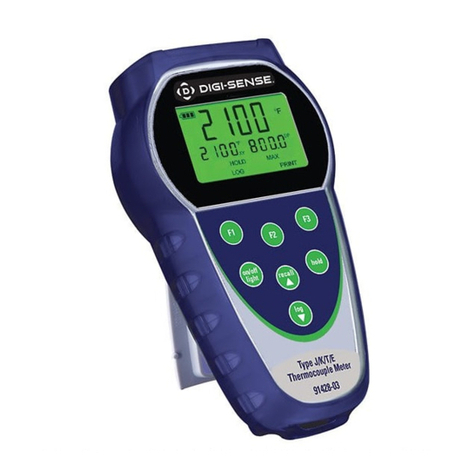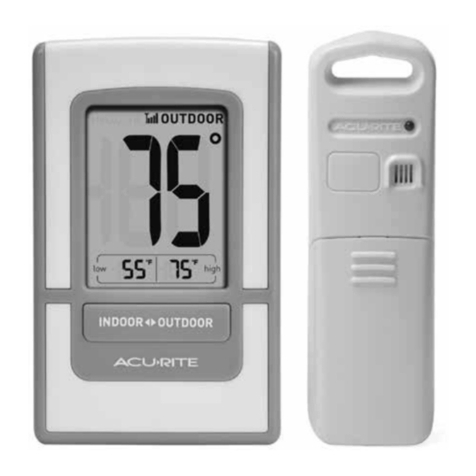Mediblink M320 User manual

EN
INSTRUCTIONS FOR USE
PLEASE READ THE INSTRUCTIONS FOR USE CAREFULLY
BEFORE USING THE PRODUCT
SLO
NAVODILA ZA UPORABO
PROSIMO, DA PRED UPORABO IZDELKA V CELOTI
PREBERETE NAVODILA ZA UPORABO
HR
UPUTE ZA UPOTREBU
PAŽLJIVO PROČITAJTE UPUTE PRIJE UPOTREBE UREĐAJA
SLO
MEDIBLINK BREZKONTAKTNI TERMOMETER M320
HR
MEDIBLINK BEZKONTAKTNI TERMOMETAR M320
EN
MEDIBLINK NON-CONTACT THERMOMETER M320


3
EN
Summary of Important Instructions for Temperature
Measurement
6
Introduction 8
Safety Instructions and Important Information Before
Using the Thermometer
9
Body Temperature Information 13
Description of Product Components 14
Description of Symbols on LCD Screen 15
Inserting and Replacing Batteries 16
Switching Between Degrees Celsius and Fahrenheit 19
Switching Between 4 Dierent Operating Modes 19
Advice for Measuring Personal Body Temperature 20
Measuring Temperature of Objects/Liquids 23
Memory 24
Care and Maintenance 25
Certicates and Standards 26
Errors and Troubleshooting 27
Technical Specications 28
EMC Tables 29
Warranty Conditions 32

4
Kratek povzetek pomembnih napotkov o meritvi
temperature
34
Uvod 36
Varnostni napotki in pomembni napotki pred uporabo
termometra
37
Informacije glede telesne temperature 41
Opis sestavnih delov izdelka 42
Opis simbolov na LCD zaslonu 43
Namestitev in zamenjava baterije 44
Preklapljanje med stopinjami Celzija in Fahrenheita 47
Menjava 4 različnih načinov merjenja temperature 47
Nasveti za merjenje osebne temperature 48
Merjenje temperature predmetov/tekočin 51
Pomnilnik 52
Nega in vzdrževanje 53
Pridobljeni certikati in standardi 54
Iskanje in odpravljanje napak (Error) 55
Tehnične specikacije 56
Elektromagnetna odpornost na motnje – EMC tabele 57
Garancijski pogoji 60
SLO

5
Kratke napomene o mjerenju tjelesne temperature 62
Uvod 64
Mjere opreza i važne obavijesti prije upotrebe
termometra
65
Informacije o tjelesnoj temperaturi 69
Opis sastavnih dijelova uređaja 70
Opis simbola na LCD zaslonu 71
Stavljanje i zamjena baterija 72
Prebacivanje između stupnjeva Celzija i Fahrenheita 75
Promjena 4 različita moda mjerenja temperature 75
Savjeti za mjerenje tjelesne temperature 76
Mjerenje temperature predmeta/tekućina 79
Memorija 80
Održavanje termometra 81
Certikati i standardi 82
Otklanjanje pogrešaka u radu uređaja (Error) 83
Tehnički podatci 84
Elektromagnetna otpornost na smetnje – EMC
tablice
85
Jamstvo 88
HR

EN
6
Summary of Important Instructions
for Temperature Measurement
These are important 2-page instructions. Please read the
instructions thoroughly before use.
1. Wait a little before starting to measure, if the thermometer
has been stored at a location where the temperature is
considerably dierent from the place of measurement.
2. The thermometer and persons whose body temperature
you are measuring should be in the same room for at least
30 minutes.
3. Do not take forehead measurements immediately after a
shower, a bath, or after arriving from the outside. You must
wait at least 30 minutes.
4. Oily forehead skin can lead to inaccurate measurement
results. Always clean your forehead before measuring the
temperature. After that, wait for approx. 5–10 minutes before
measuring the temperature. The skin must be dry.
5. The infrared sensor on the thermometer must be clean
and dry. Read more about cleaning in chapter “Care and
Maintenance”.
6. Measure the body temperature in the middle of the
forehead, as measurements on the right or left side of
the forehead may be inaccurate.
7. Do not perform any other activities while measuring the
temperature – be still.
8. Keep the sensor on the tip of the thermometer pointing
at the forehead/object at an angle of 90° before
and during the temperature measurement until the
thermometer makes a measurement.
9. The temperature must be measured at least 0.5cm
away from the object/forehead, and not more than 3 cm
away from the object/forehead/uid. Do not touch the

EN
7
forehead, object, or liquid with the thermometer.
10. It is recommended that the user performs 3 consecutive
temperature measurements. You must wait at least 1 minute
between each measurement. If the measurements dier
from each other, consider the average value.
11. Perform individual measurements at one-minute intervals,
as minor deviations may occur with multiple consecutive
measurements.
12. There are no prescribed standard values for personal
body temperature. Measure your body temperature when
you are healthy and do not have a fever. This measured
value is to serve you as a reference value to compare your
body temperature to when you have a fever. Read more
about body temperature in chapter “Body temperature
information”.
13. Temperature measured using infrared technology
on the forehead is comparable to the temperature
measured in the mouth, and is not comparable to the
temperature measured under the armpit, in the ear, or
rectal temperature. Please consult your personal physician
for any other case.
14. The temperature measured during sleep is not comparable
to the temperature measured when you are awake, as the
temperature is usually lower during sleep.
15. The thermometer allows you to measure body temperature,
uid (e.g. baby formula, water in baby's bathtub, pool water,
drink), food (e.g. baby food), object, and room temperature,
ranging from 0 to 100°C. For instructions on how to use the
thermometer, see the rest of the instructions for use.
Summary of Important Instructions
for Temperature Measurement

EN
8
Introduction
Using infrared technology, the thermometer measures the
temperature on the forehead skin surface, or on the surface
of objects in approximately one second. The product is in
accordance with the EC provisions and Directive 93/42/EEC
(MDD). The product features are:
1. 6 functions in one thermometer: body temperature, object
temperature, night mode, fever alarm, 30 memory locations,
illuminated display.
2. Night mode: switch to night mode (turn o the thermometer
beeping at the end of the measurement) so that you do not
disturb the baby while sleeping.
3. Red LED light – increased body temperature signal: This
device contains a red LED light that warns the user if the
body temperature is above 38°C. At the same time, a sound
signal is activated (only in body temperature measurement
mode).
4. 30 memory locations.
5. Illuminated LCD screen.
6. Easy to switch between °C and °F.
7. Temperature measurement in just 1 second.
8. Automatic shutdown for battery saving.
9. Empty battery indicator.
10. Large LCD screen.
11. Ergonomic design, comfortable for use:
This is a non-contact medical thermometer that allows
hygienic, clean, and easy measuring of temperature. Simply
place the thermometer near the forehead or object within
the set distance.
12. Immediate measurement. The unique technology allows
immediate and accurate measurement.

EN
9
Safety Instructions and Important Information
Before Using the Thermometer
Make sure to follow all of the instructions below when using the
product. Any failure to follow the instructions may result in injury
or aect the accuracy of the measurement.
Warning! Potential risks for children and people with
reduced physical, sensory, or mental abilities!
1. This thermometer is not intended to be used by persons
(including children) with limited physical, sensory or mental
abilities, or lack of experience and/or knowledge, unless they
are supervised by a person responsible for their safety, or
they have received instructions from such person on how to
use the thermometer.
2. Keep the thermometer out of the reach of children under
18 years of age.
3. Supervise your children all the time so they don't play with
the thermometer.
4. Children are not allowed to handle the thermometer. They
could swallow small particles or batteries and suocate.
Children could suer injures if they use the thermometer.
Warning! Risk of personal injury!
1. Improper handling of the thermometer may cause injuries.
2. Do not use the thermometer in case of malfunction. Do not
attempt to modify, disassemble or repair the thermometer,
and do not replace its parts.
3. If abnormalities occur during the use of the thermometer,
stop the use immediately and consult your physician.
4. Do not perform any other activities while measuring the
temperature.
5. If you have any doubts regarding the use of the thermometer,
please consult your physician.

EN
10
6. These instructions for use must be stored for the duration of
the product life cycle and handed over to a third party along
with the thermometer. The instructions for use should also
be accessible to third parties. The instructions for use are
an integral part of the thermometer.
7. Avoid improper use.
8. This thermometer cannot replace a consultation with a
physician, or medical treatment! The measurement results
are for comparison purposes only. In the event of a medical
problem, you should see your physician.
9. The infrared sensor should stay clean and dry. Avoid
damaging it. This is the only way to achieve accurate
measurement results.
10. Do not touch the infrared sensor or blow in it. If the infrared
sensor is dirty, the results of the measurement could be
inaccurate.
11. Do not use the thermometer if it is damaged. If you use
a damaged device, you can suer injuries, cause serious
danger, or incorrect measurement results.
12. Wait a little before starting to measure, if the thermometer
has been stored at a location where the temperature is
considerably dierent from the place of
measurement. The thermometer and persons whose body
temperature you are measuring should be in the same room
for at least 30 minutes.
13. Do not take forehead measurements immediately after a
shower, a bath, or after arriving from the outside. You must
wait at least 30 minutes.
14. It is recommended that the user performs 3 consecutive
temperature measurements. You must wait at least 1 minute
between each measurement. If the measurements dier
from each other, consider the average value.
Safety Instructions and Important Information
Before Using the Thermometer

EN
11
15. Perform individual measurements at one-minute intervals,
as minor deviations may occur with multiple consecutive
measurements.
16. Oily forehead skin can lead to inaccurate measurement
results. Always clean your forehead before measuring
the temperature. After that, wait for approx. 5–10 minutes
before measuring the temperature.
17. Repeat the measurement approximately every 15 minutes
if the measurement results are unusually low or do not
correspond to personal well-being. In this case, perform
a comparative mouth or rectal measurement with a
conventional thermometer. If you have any doubts, please
consult your physician.
18. There are no prescribed standards for personal body
temperature. Measure your body temperature when you
are healthy and do not have a fever. This measured value
is to serve you as a reference value to compare your body
temperature to when you have a fever.
19.
The measured temperature only represents a reference value.
Please consult your physician before taking any measures
based on the temperature measurement result displayed.
Warning! Risk of injury!
Improper handling of the thermometer may cause injuries.
1. Do not drop the thermometer on the oor, shake it, or expose
it to impacts.
2. To ensure accurate measurement results, protect the
infrared thermometer sensor in particular from moisture, dirt,
and damage.
3. Do not expose the thermometer to direct sunlight or to
extremely high or low temperatures. The thermometer should
be used and stored only in a dry and clean environment.
Safety Instructions and Important Information
Before Using the Thermometer

EN
12
4. If there is an interference or damage, do not open the
thermometer or try to x it yourself. Doing so would void
the warranty claim. Only authorised persons are allowed to
repair the thermometer.
5. Do not store the thermometer in a place with extreme
temperatures (below -20°C or over 50°C), or in an
extremely dry or moist place, as this could cause inaccurate
measurement results.
6. Do not use the thermometer in a wet environment. While
using the thermometer, keep it away from liquids and never
immerse it in liquid.
7. Do not place the thermometer near ammable materials
and gases or near explosives.
8. While operating, the thermometer may interfere with other
electrical devices, and other electrical devices may interfere
with its operation. Therefore, it should not be used near
other electrical devices.
9. Do not use a mobile phone near the thermometer while
you are measuring temperature. Note that portable and
mobile high-frequency communication devices (e.g. mobile
phones) may aect the operation of medical electrical
devices.
10. Do not use the thermometer at a distance of less than
1.5 metres from a shortwave or microwave device, or from
a high-frequency surgical apparatus.
11. Do not use the thermometer in the mountains at an altitude
of more than 3000 metres.
12. Medical electrical devices are subject to specic safety
regulations regarding electromagnetic compatibility.
Therefore, you must comply with these rules when installing
and using the thermometer.
13. The thermometer shall only be used for the purpose
indicated in these instructions for use.
Safety Instructions and Important Information
Before Using the Thermometer

EN
13
Body Temperature Information
Body temperature is the internal body temperature (core
temperature). It uctuates during the day: it is lowest in
the morning and highest in the late evening. Normal body
temperature is not a denitive value but a range.
Age Normal body tempera-
ture in °C
Normal body tempera-
ture in °F
0–2 years 36.4–38.0°C 97.5–100.4°F
3–10 years 36.1–37.8°C 97.0–100°F
11–65 years 35.9–37.6°C 96.6–99.7°F
over 65 years 35.8–37.5°C 96.4–99.5°F
The normal body temperature range is dierent from one person
to another, and determined by several factors: age, gender, time
of day, location and method of temperature measurement, level
of activity, well-being, drug eects, etc.
Most people have the lowest body temperature while sleeping;
however, the temperature rises during the day. Babies and
children have a higher body temperature than adults. As you
get older, your body temperature drops. Fluctuations in body
temperature are generally higher in children, and occur more
quickly and frequently.
Measurements in dierent parts of the human body give dierent
results: the temperature measured in the rectum is usually 0.3°C
higher than the temperature measured in the mouth.
The temperature measured in the mouth is approx. 0.3°C higher
than the temperature measured under the armpit. To determine
your body temperature, we recommend that you measure your
temperature when you are healthy, at dierent times of the day,
three or four days in a row. This allows you to determine your
normal body temperature and record it so you can compare the
measured temperature to your normal values when needed.

EN
14
Description of Product Components
LCD screen
Red LED light – elevated body tem-
perature indicator (only in the body
temperature mode)
MODE: Button for changing the thermom-
eter modes (measurement of personal
body temperature, temperature of objects/
liquids/ambient temperature)
SCAN: Thermometer power button/
Temperature measurement button
Measurement sensor
MEM: Memory
recall button
Battery compart-
ment cover
Sound signal
(alarm) slot

EN
15
Description of Symbols on LCD Screen
Temperature measurement is in progress
Night mode
Personal temperature
measurement mode
Object temperature
measurement mode
Sad face (indicates that the measured
body temperature is equal to or higher
than 38°C or 100.4°F)
Memory
symbol
and stored
measure-
ment serial
number
Happy face (indicates that the measured body
temperature is lower than 38°C or 100.4°F)
Measured
temperature
Degrees Celsius
Degrees Fahrenheit
Low battery indicator

EN
16
Inserting and Replacing Batteries
Warning! Risk of explosion!
Improper handling of batteries may result in explosion.
1. Only replace batteries with equal batteries or batteries of an
equivalent type.
2. Do not expose batteries to excessive heat such as the sun or
re.
3. Do not charge, re-activate, disassemble, or throw the
batteries into re, or cause a short-circuit.
Warning! Risk of personal injury!
Improper handling of batteries may result in injuries.
1. Keep the batteries out of reach of children.
2. Swallowing the batteries can be life-threatening. Therefore,
store the batteries out of reach and sight of children. If a
battery is swallowed, seek medical advice immediately.
3. If battery uid leaks, avoid contact with skin, eyes, and
mucous membranes. In case of contact with acid, wash the
aected area immediately with plenty of clean water and
immediately see your physician.
Warning! Risk of injury!
Improper handling of batteries may result in injuries.
1. When inserting the battery, make sure that the terminals are
properly oriented.
2. Only insert batteries of the same type in the battery
compartment. Do not use batteries of dierent types or used
and new batteries together.
3. If the batteries are empty or if the thermometer will not be
used for a longer period, remove the batteries from the
battery compartment.

EN
17
Inserting and Replacing Batteries
Low battery warning
Before the batteries are completely empty, the “
” symbol appears on the screen. You can still use the
thermometer while this symbol is displayed, but we
recommend that you replace the batteries as soon
as possible. If the batteries are completely empty,
the “Lo” symbol will appear on the screen next to the empty bat-
tery symbol. In this case, you must replace the batteries before
using them again.If the batteries are empty or you replace the
used batteries, all entries in the memory will be erased!
Changing the batteries
1. To open the battery compartment
cover, press the locking clip on the
back of the thermometer and slide the
cap o.
2. Carefully remove the old batteries.
3. Insert 2 new batteries (1.5V alkaline
batteries, AAA size) into the battery
compartment. When inserting the
batteries, make sure that the terminals are properly oriented
(the + and – terminals on the batteries and on the bottom
of the battery compartment must match). Do not use
rechargeable batteries!
4. Put the battery compartment cover back on, and slide it into
the thermometer housing until it clicks into place.

EN
18
Disposal
Disposal of packaging
For disposal, separate the packaging by the type
of material. For disposal, handle paperboard
and cardboard as waste paper, and the foil as
secondary raw materials.
Disposal of waste product
(Applicable to the European Union and other European
countries with systems for separate collection of secondary raw
materials.)
Waste devices may not be disposed together with
household waste!
When the thermometer is no longer functioning, the consumer
is legally required to dispose of the old product separately
from household waste, e.g. at the collection point
of their municipality/area where they reside. This
will ensure that the old devices are professionally
recycled and that negative environmental impacts
are prevented. Therefore, electrical devices are
marked with the symbol shown here.
Put the thermometer in waste electrical and
electronic equipment in accordance with EC
Directive 2012/19/EU.
Batteries and rechargeable batteries may not be disposed
together with household waste!
As a consumer, you are required by law to dispose
of all batteries and rechargeable batteries, whether
or not they contain harmful substances*, at a
collection point in your municipality/area or at a
store, in an environmentally friendly manner.
* with the following elements: Cd = cadmium; Hg = mercury;
Pb = lead
Inserting and Replacing Batteries

EN
19
Switching Between Degrees Celsius and Fahrenheit
Switching Between 4 Dierent Operating Modes
The thermometer can display results in both
degrees Celsius (°C) and Fahrenheit (°F).
To switch between degrees Celsius and Fahrenheit,
make sure the device is turned on and simultane-
ously press the MEM and MODE buttons briey.
This will change the mode from °C to °F or vice
versa.
1. While the thermometer is switched
on, you can switch between dierent
modes of temperature measurement by
pressing the MODE button. There are
4 dierent measurement modes avail-
able: body temperature measurement,
body temperature measurement in night
mode, object temperature measure-
ment, object temperature measurement
in night mode (in this exact order).
2. The thermometer does not beep when
the night mode is selected (Body tem-
perature measurement in night mode
or Object temperature measurement
in night mode). In night mode, a moon
symbol will also appear on the LCD
screen.
Note: When pressing the MODE button and switching be-
tween individual operating modes, the thermometer will beep,
except in the night mode.
Body temperature
measurement mode
Object temperature
measurement mode
Object, liquid and
room temperature
measurement in
night mode
Body temperature
measurement in
night mode

EN
20
Advice for Measuring Personal Body Temperature
1. Wait a little before starting to measure, if the thermometer
has been stored at a location where the temperature is
considerably dierent from the place of measurement.
2. The thermometer and persons whose body temperature
you are measuring should be in the same room for at least
30 minutes.
3. Do not take forehead measurements immediately after a
shower, a bath, or after arriving from the outside. You must
wait at least 30 minutes.
4. Oily forehead skin can lead to inaccurate measurement
results. Always clean your forehead before measuring
the temperature. After that, wait for approx. 5–10 minutes
before measuring the temperature. The skin must be dry.
5. The infrared sensor on the thermometer must be clean
and dry. Read more about cleaning in chapter “Care and
Maintenance”.
6. Measure the body temperature in the middle of the
forehead, as measurements on the right or left side of
the forehead may be inaccurate.
7. Do not perform any other activities while measuring the
temperature – be still.
8. Keep the sensor on the tip of the thermometer pointing
at the forehead/object at an angle of 90° before
and during the temperature measurement until the
thermometer makes a measurement.
9. The temperature must be measured at least 0.5cm
away from the object/forehead, and not more than 3 cm
away from the object/forehead/uid. Do not touch the
forehead, object, or liquid with the thermometer.
10. It is recommended that the user performs 3 consecutive
temperature measurements. You must wait at least 1 minute
Table of contents
Languages:
Other Mediblink Thermometer manuals

